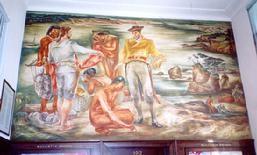
The story of Tillamook County began on August 14, 1788 when Captain Robert Gray, an American sailing the sloop “Lady Washington,” anchored in Tillamook Bay thinking he had found the “great river of the West.” This was the first landing on the Oregon coast.
In its early years, the town of Tillamook, the first community to be settled in the county, bore the unofficial names Lincoln and Hoquarton, the latter believed to be an Indian name meaning “the landing.” Its name was eventually changed to Tillamook, an Indian word meaning “the many peoples of the Nehelim.” William Clark of explorers Lewis and Clark wrote in 1806 of the “Killamox” Indians but according to research by the Clatsop-Nehalem Confederated Tribes the “K” was not used in the name of the tribe. Local folklore used “Land of Many Waters” as the meaning of Tillamook. Though it is a fact that Tillamook is a land of many waters it is not the true meaning of the name Tillamook.
In 1890 American anthropologist Franz Boas writes, “The Tillamook Indians are the most southern branch of the Coast Salish. They live on the coast of the Pacific Ocean, and are separated from their more northern kinsmen by tribes speaking Chinookian languages. Their language is spoken two dialects, the Siletz and the Tillamook proper. It was first described and classified by Horatio Hale in the Publications of the Wilkes Expedition. The name Tillamook, by which the tribe is best known, is of Chinook origin. It means the people of Nekelim (pronounced Ne-elim) . The latter name means the place Elim, or, in the Cathlamet dialect, the place Kelim. The initial “t” of Tillamook is the plural article, the terminal “ook” the Chinook plural ending — “uks”. The dialect differs from the northern dialects in its peculiar phonetics. It has lost almost entirely the labials which, so far as I am aware, occur in a few names of places only. The culture of the Tillamook seems to have differed quite considerably from that of the northern Coast Salish, and has evidently been influenced by the culture of the tribes of northern California.” (Note: parenthesis added for emphasis)
The first settler in the vicinity was Joseph Champion, who came in 1851 and made his home in a hollow spruce tree he called his “castle.” Within months other settlers came – all bachelors.
In 1852, the first two families arrived to make their homes. Each successive year brought more families. On Dec. 15, 1853, Tillamook County was created by an act of legislature.
In 1854, the first election was held, the first census taken, the first school started and the keel laid for a community ship: the “Morning Star.”
The “Morning Star” was built out of economic necessity because shipwrecks had destroyed all transportation that had carried local dairy products, fish and potatoes to market. The vessel was built by the combined efforts of Tillamook’s settlers. Most of the materials came from the forest, but iron work from a wrecked ship was laboriously packed on horseback from the Clatsop beaches by way of Neahkahnie Mountain. Sails were purchased from the Indians who had salvaged them from a ship wrecked near Netarts. Pitch was used to caulk the craft. Paint was not available. The ship was launched in the Kilchis River on Jan. 5, 1855, and for some years made possible the existence of the pioneers and development of Tillamook County.
In 1861 Thomas Stillwell, aged 70, arrived with his family from Yamhill and purchased land. The following year he laid out the town that would become Tillamook and opened the first store. In 1866 the first post office was opened and the town was permanently renamed Tillamook. An election in 1873 chose Tillamook as the county seat. The first public building was the jail built that same year.
Tillamook became an incorporated city in 1891. The first County Courthouse and City Hall were erected in the early 1890s.
Today, Tillamook’s City Hall is located at 210 Laurel and occupies the former Tillamook Post Office, which moved to a new facility on 1st Street in 1986. The building is listed on the National Register of Historical Places. It opened as a post office in 1925. In 1943, as part of a national public works program, the U.S. Treasury Department commissioned native Tillamooker Lucia Wiley to paint a mural on one inside wall of the building. It is entitled “The Landing of Captain Robert Gray in 1788.”
HISTORY OF THE FRESCO PAINTED BY SISTER LUCIA WILEY
Lucia Wiley (1906-1998), a third generation Tillamookian, was one of a family of six children. She was born in Tillamook, Oregon on August 14, 1906. She was the daughter of Wayne and Frances Wiley. After graduating from high school in Tillamook, she attended the University of Oregon and received a Bachelor of Arts degree. She did post graduate work at the University of Minnesota and received a Master of Fine Arts degree from the University of Oregon in 1932. She returned to Minnesota and painted frescos in the Long Prairie, MN post office, International Falls, MN post office, the Shelbyville, IL post office, the Moorhead MN post office, the Miller Vocational High School, Minneapolis, MN (“Youth marches on Toward Life of Service”), and the Minnesota National Guard Armory (“Peace and War”).
From 1942 to 1945, Lucia lived again in Tillamook and did two frescos. The first was for the Tillamook Post Office. This fresco secco entitled “The Landing of Captain Robert Gray in 1788″ was installed in 1943. The Post office building is on the National Register of Historic Places and is now used as the Tillamook City Hall. The second fresco was painted in the Tillamook County Court House.
In 1955, Miss Wiley left Portland, Oregon for New York City where she entered the Episcopal order of the Community of Holy Spirit. She became principal of the lower school at St. Hilda’s and St. Hugh’s school in New York. Sister Lucia also did illustrations in the Book of Common Prayer, “Our Prayers and Praises” printed in 1958. She received the prestigious “Medal of Honor” awarded by the National Society of the Daughters of the American Revolution for outstanding community service in 1985 and was named one of the “Eight Best Mural Painters” in the nation. September 20, 1987 was declared “Sister Lucia Wiley Day” in Tillamook, Oregon. She died in 1998. Sister Lucia was known as a foremost painter of true fresco and a woman of great spirituality and community service.
The fresco in the now Tillamook City Hall, is titled “The Landing of Captain Robert Gray in 1788”. This mural depicts Captain Gray, who is best known for discovery of the Columbia River in the year 1792. Four years prior to that, however, he became the first white man, on record, to set foot on Oregon’s shore. On the same voyage, he was the first to carry the American flag around the world. Residents of Tillamook County find special interest in the log of his visit. The log tells of the four days spent in what is now Tillamook Bay. He believed he had discovered the “Great River of the West,” something all nations were seeking.
Early Tillamook
Tillamook County Historical Society has researched for many years the history of the early Tillamook Indians and Pioneers. To contact the TCHS please click on this link to the Tillamook County Pioneer Museum Web site and click on Historical Society.

Tillamook City Hall

City Hall Mural – The Landing of Captain Robert Gray in 1788 – Painted by Sister Lucia Wiley
